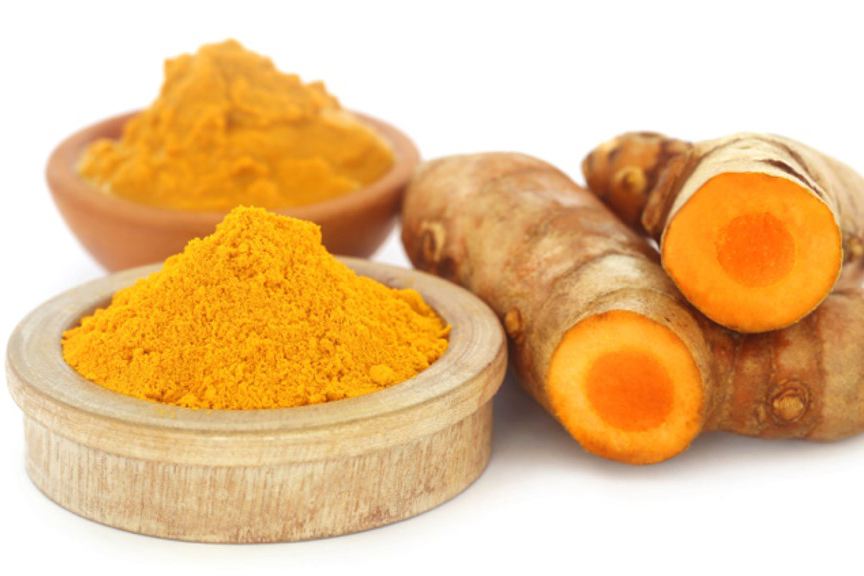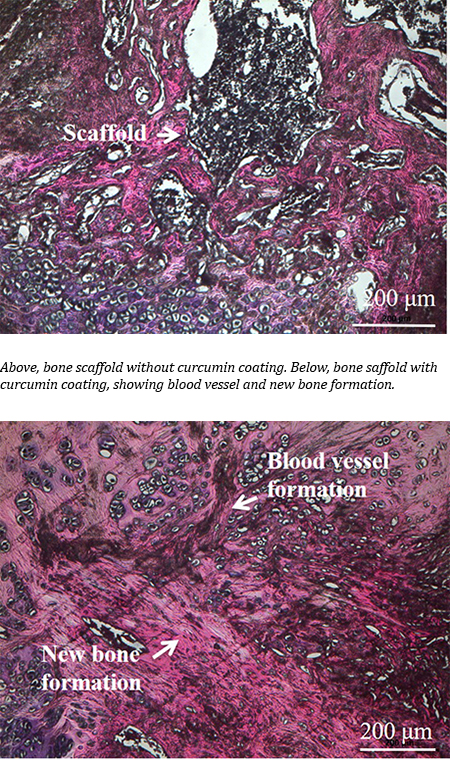Curry was how I was introduced to turmeric. My father who came from Mauritius loved curry and we had it at least once a week. Nobody mentioned healing properties, which I was to discover them only after I started this blog. Usually, turmeric is mentioned in cancer cures but not this time.

Turmeric Courtesy: Washington State University
From a May 2, 2018 Washington State University news release by Tina Hilding (also on EurekAlert but dated May 3, 2018),
A WSU research team is bringing together natural medical cures with modern biomedical devices in hopes of bringing about better health outcomes for people with bone diseases.
In this first-ever effort, the team improved bone-growing capabilities on 3D-printed, ceramic bone scaffolds by 30-45 percent when coated with curcumin, a compound found in the spice, turmeric. They have published their work in the journal, Materials Today Chemistry.
The work could be important for the millions of Americans who suffer from injuries or bone diseases like osteoporosis.
Human bone includes bone forming and resorbing cells that constantly remodel throughout our lives. As people age, the bone cell cycling process often doesn’t work as well. Bones become weaker and likely to fracture. Many of the medicines used for osteoporosis work by slowing down or stopping the destruction of old bone or by forming new bone. While they may increase bone density, they also create an imbalance in the natural bone remodeling cycle and may create poorer quality bone.
Turmeric has been used as medicine for centuries in Asian countries, and curcumin has been shown to have antioxidant, anti-inflammatory and bone-building capabilities. It can also prevent various forms of cancers. However, when taken orally as medicine, the compound can’t be absorbed well in the body. It is metabolized and eliminated too quickly.
Led by Susmita Bose, Herman and Brita Lindholm Endowed Chair Professor in the School of Mechanical and Materials Engineering, the researchers encased the curcumin within a water-loving polymer, a large molecule, so that it could be gradually released from their ceramic scaffolds. The curcumin increased the viability and proliferation of new bone cells and blood vessels in surrounding tissue as well as accelerated the healing process.
Bose hopes that the work will lead to medicines that naturally create healthier bone without affecting the bone remodeling cycle.
“In the end, it’s the bone quality that matters,” she said.
The researchers are continuing the studies, looking at the protein and cellular level to gain better understanding of exactly how the natural compound works. They are also working to improve the process’ efficiency and control. The challenge with the natural compounds, said Bose, is that they are often large organic molecules.
“You have to use the right vehicle for delivery,” she said. “We need to load and get it released in a controlled and sustained way. The chemistry of vehicle delivery is very important.”
In addition to curcumin, the researchers are studying other natural remedies, including compounds from aloe vera, saffron, Vitamin D, garlic, oregano and ginger. Bose is focused on compounds that might help with bone disorders, including those that encourage bone growth or that have anti-inflammatory, infection control, or anti-cancer properties.
Starting with her own health issues, Bose has had a longtime interest in bridging natural medicinal compounds with modern medicine. That interest increased after she had her children.
“As a mother and having a chemistry background, I realized I didn’t want my children to be exposed to so many chemicals for every illness,” Bose said. “I started looking at home remedies.”
To her students, she always emphasizes healthy living as the best way to guarantee the best health outcomes, including healthy eating, proper sleep, interesting hobbies, and exercise.

Courtesy Washington State University
Here’s a link to and a citation for the paper,
Effects of PCL, PEG and PLGA polymers on curcumin release from calcium phosphate matrix for in vitro and in vivo bone regeneration by Susmita Bose, Naboneeta Sarkar, Dishary Banerjee. Materials Today Chemistry Vol. 8 June 2018, pp. 110-130 [Published online May 2, 2018] https://doi.org/10.1016/j.mtchem.2018.03.005
This paper is behind a paywall.